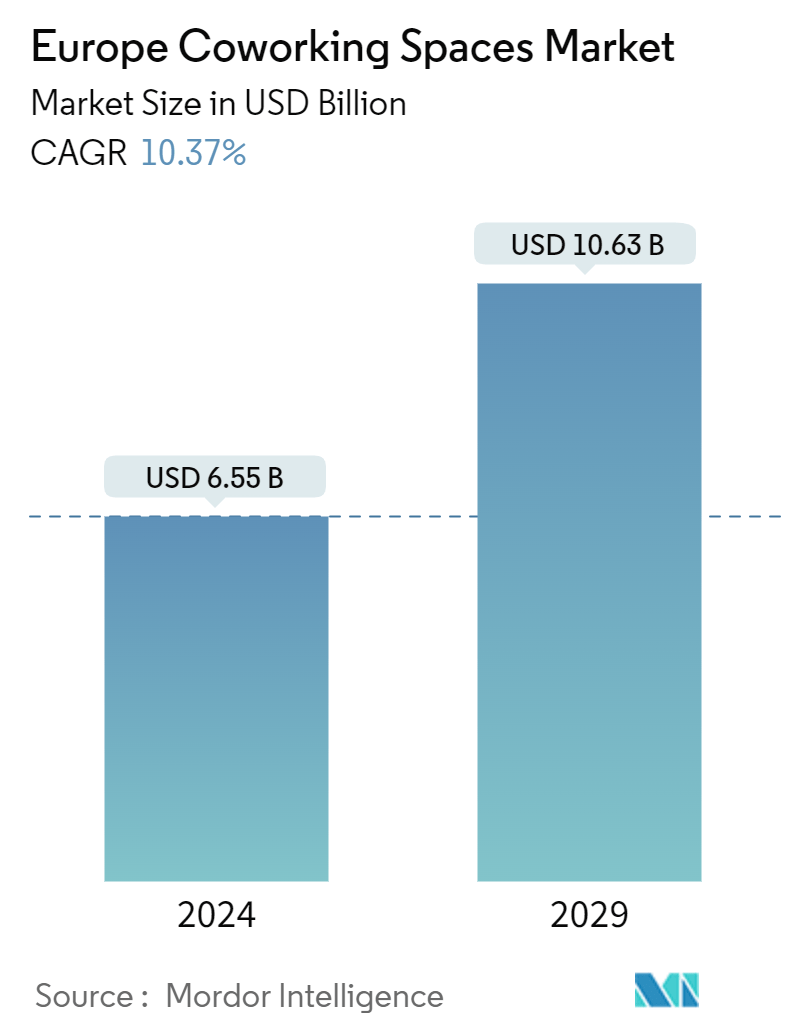Market Size of Europe Coworking Spaces Industry

| Study Period | 2020 - 2029 |
| Market Size (2024) | USD 6.55 Billion |
| Market Size (2029) | USD 10.63 Billion |
| CAGR (2024 - 2029) | 10.37 % |
| Largest Market | Asia Pacific |
| Market Concentration | Low |
Major Players
*Disclaimer: Major Players sorted in no particular order |
Europe Coworking Spaces Market Analysis
The Europe Coworking Spaces Market size is estimated at USD 6.55 billion in 2024, and is expected to reach USD 10.63 billion by 2029, growing at a CAGR of 10.37% during the forecast period (2024-2029).
- The coworking spaces market in Europe defied the odds in 2023, according to Workthere. The flexible office specialist estimated that operators would continue to look for top-of-the-line spaces with more emphasis on facilities and sustainability in 2024.
- With talent attraction and retention at all-time highs, there will continue to be a demand for top-of-the-line space, and operators will need to step up their game by offering more amenities. To compete for tenants and attract new ones, operators are already setting standards that go beyond gyms, yoga, cafes, and outdoor space to include amenities like five-star hotels with private chefs or rooftop bars.
- While occupiers are looking for the best locations, they are also looking for locations that offer the best transport connections and full amenities for their employees. For many markets, this has led to an increase in the number of flex office operators operating in central business districts (CBDs), which is expected to continue in 2024. On the other hand, a shortage of office space in Europe, particularly in major cities such as Madrid, Munich, and Barcelona, where vacancy rates are well below 5%, will have a major impact on occupancies and availability.
- Operational costs have increased over the last two years, impacting profit margins for a number of operators, and while the desk prices increased at the high end in most European cities, it has been more difficult at the low end. Operators are projected to place a genuine emphasis on profitability in 2024 by looking for opportunities to grow margin outside of desk rates and by looking at ancillary revenue, including through more sales of meeting rooms and events, more sales of coworking desks, or upselling technology packages to their customers.
Europe Coworking Spaces Industry Segmentation
Coworking is an arrangement where workers from different companies share an office space, allowing for cost savings and convenience using common infrastructure.
The European coworking spaces market is segmented by business type (new spaces, expansions, and chains), business model (sub-lease model, revenue sharing model, and owner-operator model), end user (independent professionals, startup teams, small to medium-sized enterprises (SMEs), and large-scale corporations), and country (the United Kingdom, France, Germany, Spain, Italy, and the Rest of Europe). The report offers market sizes and forecasts in value (USD) for all the above segments.
| By Business Type | |
| New Spaces | |
| Expansions | |
| Chains |
| By Business Model | |
| Sub-lease Model | |
| Revenue Sharing Model | |
| Owner-operator Model |
| By End User | |
| Independent Professionals | |
| Startup Teams | |
| Small to Medium-sized Enterprises (SMEs) | |
| Large-scale Corporations |
| By Country | |
| United Kingdom | |
| France | |
| Germany | |
| Spain | |
| Italy | |
| Rest of Europe |
Europe Coworking Spaces Market Size Summary
The European coworking spaces market is experiencing significant growth, driven by the increasing demand from entrepreneurs, startups, and freelancers who prioritize flexibility, cost-effectiveness, and convenience. This trend is particularly evident in major cities like London and Paris, where the demand for flexible workspaces has surged. In London, central areas such as the City, West End, and Midtown have seen a substantial increase in flexible office space deals, reflecting a broader shift towards leasing arrangements that offer more flexibility and cost savings. Similarly, in France, the coworking sector has revitalized the office real estate market, with Paris attracting considerable investment despite a concentrated supply. The evolution of coworking spaces is marked by a move towards larger units and strategies that cater to both individual freelancers and larger project-based teams, aligning with the needs of a dynamic workforce.
The coworking industry in Europe is characterized by a fragmented market with numerous players, including prominent companies like Regus/IWG and WeWork, which have made significant investments in the region. These companies are expanding their presence to meet the growing demand for casual and flexible office environments. The appeal of well-designed and flexible workspaces is particularly strong among millennials and younger talent, who view such options as desirable and are increasingly influenced by them in their job choices. As the market continues to grow, the competition among coworking space providers intensifies, with companies striving to attract and retain talent by offering innovative and adaptable workspace solutions.
Europe Coworking Spaces Market Size - Table of Contents
-
1. MARKET DYNAMICS
-
1.1 Market Overview
-
1.2 Market Drivers
-
1.2.1 Increasing Number of Startups and Small Businesses in Europe Looking for Flexible and Affordable Office Space
-
1.2.2 Rise of Remote Work and Growing Demand for More Flexible Work Arrangements
-
-
1.3 Market Restraints
-
1.3.1 Economic Uncertainties Affecting the Progress
-
1.3.2 Competition from Traditional Office Space Providers
-
-
1.4 Market Opportunities
-
1.4.1 Partnerships with Traditional Office Space Providers
-
1.4.2 Emphasis on Community Building
-
-
1.5 Industry Attractiveness - Porter's Five Forces Analysis
-
1.5.1 Threat of New Entrants
-
1.5.2 Bargaining Power of Buyers/Consumers
-
1.5.3 Bargaining Power of Suppliers
-
1.5.4 Threat of Substitute Products
-
1.5.5 Intensity of Competitive Rivalry
-
-
-
2. MARKET SEGMENTATION
-
2.1 By Business Type
-
2.1.1 New Spaces
-
2.1.2 Expansions
-
2.1.3 Chains
-
-
2.2 By Business Model
-
2.2.1 Sub-lease Model
-
2.2.2 Revenue Sharing Model
-
2.2.3 Owner-operator Model
-
-
2.3 By End User
-
2.3.1 Independent Professionals
-
2.3.2 Startup Teams
-
2.3.3 Small to Medium-sized Enterprises (SMEs)
-
2.3.4 Large-scale Corporations
-
-
2.4 By Country
-
2.4.1 United Kingdom
-
2.4.2 France
-
2.4.3 Germany
-
2.4.4 Spain
-
2.4.5 Italy
-
2.4.6 Rest of Europe
-
-
Europe Coworking Spaces Market Size FAQs
How big is the Europe Coworking Spaces Market?
The Europe Coworking Spaces Market size is expected to reach USD 6.55 billion in 2024 and grow at a CAGR of 10.37% to reach USD 10.63 billion by 2029.
What is the current Europe Coworking Spaces Market size?
In 2024, the Europe Coworking Spaces Market size is expected to reach USD 6.55 billion.

